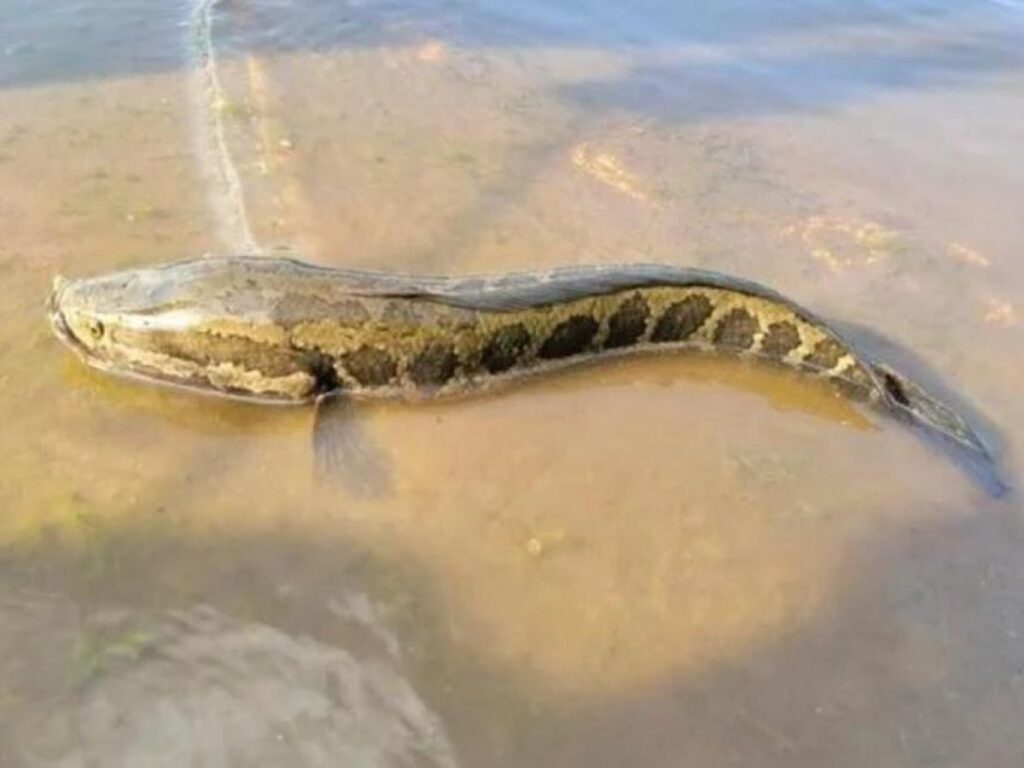Invasive species pose a persistent threat to ecological balance, and one of the most disturbing arrivals to environments across the United States is the snakehead fish. Renowned for its predatory instincts and extraordinary capacity to endure out of water, the snakehead fish has become a significant concern for officials in both the U.S. and Europe.
A Fish with Extraordinary Traits
The northern snakehead (Channa argus)—named for the striking snake-like appearance of its head—has been creating ripples—both literally and metaphorically—throughout the country. This fish, characterized by its prominent, beady eyes, is not just another invasive species; it represents a remarkable survivor. Its most unsettling attribute is its ability to breathe air, which allows it to thrive in low-oxygen waters and astonishingly to live outside water for days, provided its skin remains damp.
The resilience of the snakehead was brought to light again in 2024 when a fisherman in Missouri captured one and believed it would perish after being left on the pavement for hours. Surprisingly, the fish survived. Dave Knuth, a biologist with the Missouri Department of Conservation, pointed out that the fish’s air-breathing capacity is essential for its survival and ability to invade new environments.
An Aggressive Predator Lacking Natural Rivals
What sets the northern snakehead apart as particularly perilous is its aggressive feeding behavior. This species is not just an opportunistic eater; it’s a ruthless predator. Armed with a mouth full of sharp, pike-like teeth, the snakehead consumes nearly anything that fits into its expansive jaws. From small fish and amphibians to birds, nothing is off the menu.
The snakehead’s impressive size—growing up to a meter long and weighing as much as 5 kilograms—makes it a formidable presence in aquatic habitats. Its predatory nature allows it to dominate local resources, claiming territory with alarming efficiency. Notably, it can reproduce up to five times a year, with each female capable of laying around 50,000 eggs at once. This reproductive rate facilitates rapid population growth, creating significant pressure on native species.
Why the Alarm Is Rising
The snakehead’s incursion into U.S. waters is no mere accident. Hailing from Asia, it was introduced far from its natural range mainly due to human activities like the pet trade and aquarium releases. Its unmatched adaptability and invasive characteristics have allowed it to flourish in environments far removed from its original habitat. The International Union for Conservation of Nature has officially listed the snakehead among its invasive species of concern, highlighting the environmental havoc it wreaks.
This fish has also emerged as a concern across Europe, where it threatens local biodiversity. Its ability to disrupt ecosystem dynamics and monopolize habitats poses a serious challenge for environmental management authorities.
An Escalating Menace
With its survival prowess, aggression, and capacity for rapid reproduction, the snakehead is an escalating threat to environments in the U.S. and elsewhere. Its swift adaptation and dissemination have raised red flags among scientists, prompting calls for more stringent measures to curb its advance. The Missouri Department of Conservation and other agencies are mobilizing efforts to educate the public and prevent the snakehead from spreading further.
This scenario starkly illustrates how quickly an invasive species can establish itself and disrupt the natural order. Although the snakehead is still in the early phases of its invasion, it serves as a cautionary tale about how certain organisms have evolved survival mechanisms that challenge our understanding of ecological interactions.
The snakehead fish is more than just a biological curiosity; it represents a serious threat that has already begun to reshape ecosystems. If permitted to proliferate unchecked, it risks inflicting lasting damage to local biodiversity. As scientists delve deeper into the complexities of this remarkable yet menacing species, a key message emerges: in the war against invasive species, knowledge and proactive measures are essential to staying ahead of the curve.







